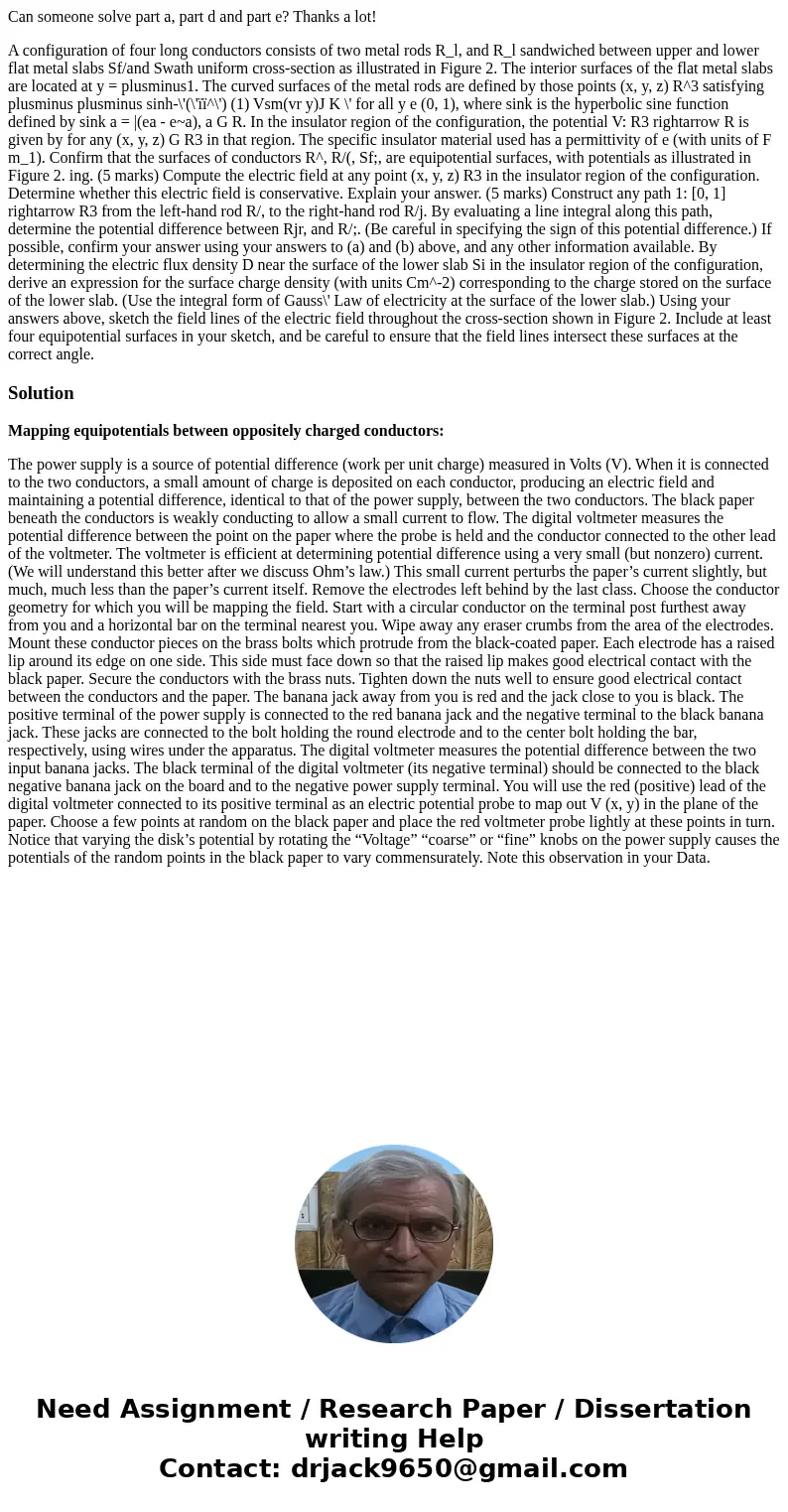Can someone solve part a part d and part e Thanks a lot A co
Can someone solve part a, part d and part e? Thanks a lot!
A configuration of four long conductors consists of two metal rods R_l, and R_l sandwiched between upper and lower flat metal slabs Sf/and Swath uniform cross-section as illustrated in Figure 2. The interior surfaces of the flat metal slabs are located at y = plusminus1. The curved surfaces of the metal rods are defined by those points (x, y, z) R^3 satisfying plusminus plusminus sinh-\'(\'ïï^\') (1) Vsm(vr y)J K \' for all y e (0, 1), where sink is the hyperbolic sine function defined by sink a = |(ea - e~a), a G R. In the insulator region of the configuration, the potential V: R3 rightarrow R is given by for any (x, y, z) G R3 in that region. The specific insulator material used has a permittivity of e (with units of F m_1). Confirm that the surfaces of conductors R^, R/(, Sf;, are equipotential surfaces, with potentials as illustrated in Figure 2. ing. (5 marks) Compute the electric field at any point (x, y, z) R3 in the insulator region of the configuration. Determine whether this electric field is conservative. Explain your answer. (5 marks) Construct any path 1: [0, 1] rightarrow R3 from the left-hand rod R/, to the right-hand rod R/j. By evaluating a line integral along this path, determine the potential difference between Rjr, and R/;. (Be careful in specifying the sign of this potential difference.) If possible, confirm your answer using your answers to (a) and (b) above, and any other information available. By determining the electric flux density D near the surface of the lower slab Si in the insulator region of the configuration, derive an expression for the surface charge density (with units Cm^-2) corresponding to the charge stored on the surface of the lower slab. (Use the integral form of Gauss\' Law of electricity at the surface of the lower slab.) Using your answers above, sketch the field lines of the electric field throughout the cross-section shown in Figure 2. Include at least four equipotential surfaces in your sketch, and be careful to ensure that the field lines intersect these surfaces at the correct angle.Solution
Mapping equipotentials between oppositely charged conductors:
The power supply is a source of potential difference (work per unit charge) measured in Volts (V). When it is connected to the two conductors, a small amount of charge is deposited on each conductor, producing an electric field and maintaining a potential difference, identical to that of the power supply, between the two conductors. The black paper beneath the conductors is weakly conducting to allow a small current to flow. The digital voltmeter measures the potential difference between the point on the paper where the probe is held and the conductor connected to the other lead of the voltmeter. The voltmeter is efficient at determining potential difference using a very small (but nonzero) current. (We will understand this better after we discuss Ohm’s law.) This small current perturbs the paper’s current slightly, but much, much less than the paper’s current itself. Remove the electrodes left behind by the last class. Choose the conductor geometry for which you will be mapping the field. Start with a circular conductor on the terminal post furthest away from you and a horizontal bar on the terminal nearest you. Wipe away any eraser crumbs from the area of the electrodes. Mount these conductor pieces on the brass bolts which protrude from the black-coated paper. Each electrode has a raised lip around its edge on one side. This side must face down so that the raised lip makes good electrical contact with the black paper. Secure the conductors with the brass nuts. Tighten down the nuts well to ensure good electrical contact between the conductors and the paper. The banana jack away from you is red and the jack close to you is black. The positive terminal of the power supply is connected to the red banana jack and the negative terminal to the black banana jack. These jacks are connected to the bolt holding the round electrode and to the center bolt holding the bar, respectively, using wires under the apparatus. The digital voltmeter measures the potential difference between the two input banana jacks. The black terminal of the digital voltmeter (its negative terminal) should be connected to the black negative banana jack on the board and to the negative power supply terminal. You will use the red (positive) lead of the digital voltmeter connected to its positive terminal as an electric potential probe to map out V (x, y) in the plane of the paper. Choose a few points at random on the black paper and place the red voltmeter probe lightly at these points in turn. Notice that varying the disk’s potential by rotating the “Voltage” “coarse” or “fine” knobs on the power supply causes the potentials of the random points in the black paper to vary commensurately. Note this observation in your Data.

 Homework Sourse
Homework Sourse